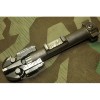justin22885
member
- Joined
- Nov 9, 2009
- Messages
- 2,102
ive been looking around at some other ideas and found something that is very simple in function.. strong, reliable, and i believe i can simplify it a great deal and make it work for me.. that is the roller locked system (not roller delayed)
the roller locked system appears to work in the same way as the G41/G43 bolt where the firing pin pushes the rollers out of the recesses in the bolt, locking the bolt into the barrel (as is the case on the MG-42) and with this system you need no cam.. firing pin pushes the rollers out, the fact theyre rollers will push themselves in when the firing pin is pulled a bit and the carrier pulls it back.. very simple and can obviously handle 8mm mauser
the roller locked system appears to work in the same way as the G41/G43 bolt where the firing pin pushes the rollers out of the recesses in the bolt, locking the bolt into the barrel (as is the case on the MG-42) and with this system you need no cam.. firing pin pushes the rollers out, the fact theyre rollers will push themselves in when the firing pin is pulled a bit and the carrier pulls it back.. very simple and can obviously handle 8mm mauser











